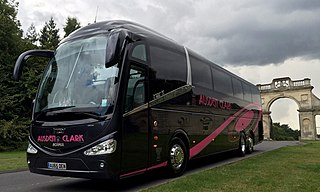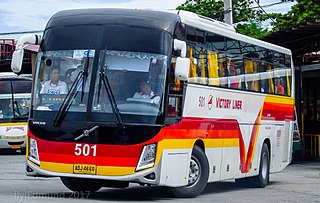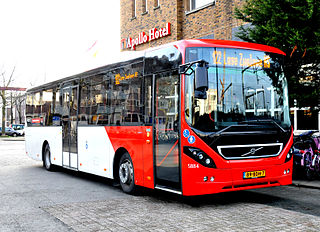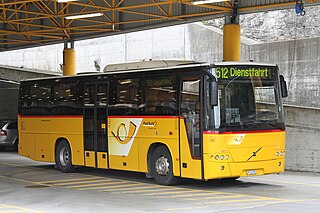
Scania AB, stylised SCANIA in its products, is a major Swedish manufacturer headquartered in Södertälje, focusing on commercial vehicles—specifically heavy lorries, trucks and buses. It also manufactures diesel engines for heavy vehicles as well as marine and general industrial applications.

A coach is a type of bus built for longer-distance service, in contrast to transit buses that are typically used within a single metropolitan region. Often used for touring, intercity, and international bus service, coaches are also used for private charter for various purposes. Coaches are also related and fall under a specific category/type of RVs.

Volvo Buses, stylized as VOLVO, is a subsidiary and a business area of the Swedish vehicle maker Volvo, which became an independent division in 1968. It is based in Gothenburg.

The Volvo B7R is a coach chassis available with a range of bodies. It is promoted as a rear engined lightweight coach chassis. It is primarily intended for tourist and long-distance duties. B7R is also manufactured in China, Brazil, Hungary, India and Iran for use in regional transport services.

The Irizar PB is a coach body manufactured by the Irizar Group from 2001 to 2015. It was built upon of the wide range of chassis. It was designed by Arup Design Research in the UK. Its revolutionary styling and features led to the variant with a Scania chassis being named European Coach of the Year 2004.

Jonckheere was a Belgian motor coach and bus builder, founded in 1881 by Henri Jonckheere in Roeselare.

The Volvo B12B was a rear-engined coach and intercity bus chassis built by Volvo. It is built as a direct replacement of Volvo B12 in the European market and the Volvo B10B.

The Wright Eclipse is a low-floor single-deck bus body that was built by Wrightbus between 2000 and 2019. The second-generation Eclipse 2 was launched in 2008, followed by the third-generation Eclipse 3 in 2015. The Eclipse, and its sister design the Solar, were named for a solar eclipse which was visible in the UK in 1999, the year of its introduction.

Drögmöller was a motor coach manufacturer based in Heilbronn, Germany. The company operated between 1920 and 2005 and was known for the production of touring coaches.

The Optare Olympus is a double-decker bus built by Optare, East Lancs and Darwen. It could be built as a body available on Alexander Dennis Enviro400, Volvo B9TL or Scania N230UD/N270UD chassis with the 2-axle and 3-axle variants. It is the double-decker equivalent of the Optare Esteem. Some 3-axle Olympus buses were built.

The Caetano Levante is a coach body built by Salvador Caetano on Mercedes-Benz OC 500 RF, Scania K EB, Volvo B8R, Volvo B9R, Volvo B11R, Volvo B12B and Volvo B13R chassis, exclusively for National Express in the United Kingdom. It was specifically designed to comply with the Disability Discrimination Act 2005.

The Volvo C10M was a semi-integral coach introduced by Volvo in 1984. C10M was also a coach chassis based on the Volvo B10M. While the normal B10M chassis had the engine mounted right behind the front axle, the C10M had it centered between the front and rear axle, providing even better weight balance.

Volvo B13R is a 12.8-litre engined coach chassis available as both two- and tri-axle from Volvo since 2009. It was the first of the Volvo BXXR series, replacing the higher output configurations of the B12B. It was later joined by the B11R, which has the same base chassis but a smaller engine. However, because Volvo decided not to upgrade the D13 engine to comply with the Euro 6 emission requirements, it was replaced by the B11R in the European market, but is still available at other markets, like Mexico. The B13R is easy recognisable as being the only modern Volvo coach chassis with air intakes on the right-hand side.

The Volvo B11R is a 10.8-litre engined coach chassis available as both two- and tri-axle from Volvo since 2011. It was introduced as the second of the Volvo BXXR series, replacing the rest of the B12B range in 2011, and later its fellow BXXR platform model, the B13R in 2013.

The Volvo B8R is a 7.7-litre engined coach and intercity bus chassis manufactured by Volvo since 2013 for Euro VI markets. It was designed as a replacement for the B7R and the B9R.

The Volvo 9900 is a coach manufactured by Volvo, best known for its theatrical floor. The first generation was built by Drögmöller in Heilbronn, Germany, between 2001 and 2005. The second generation was introduced in 2007 as a member of the Volvo 9700 family and has since then been built at Volvo Polska Sp. z o.o. in Wrocław, Poland. The third generation was introduced in 2013.

The Volvo B8RLE is a 7.7-litre-engined low-entry bus chassis manufactured by Volvo since 2013 for left-hand drive markets. It was designed as a replacement for the B7RLE and the B9RLE. The right-hand drive version was launched in November 2014.

The Volvo 8900 is a single-decker city bus and intercity bus, first introduced in 2010 as a cross-breed successor to both the aluminium body 8500 and the stainless steel body 8700, taking advantage of both techniques. It is available both with 860 mm step-entrance floor and as the low-entry Volvo 8900LE, and since 2024, is offered on the Volvo BZR chassis as a battery electric bus.

The Volvo 8700 is a single-decker city and single-decker intercity bus from Volvo manufactured between 2002 and 2011. It was available both with medium floor and as the low-entry Volvo 8700LE, which was even built as the articulated Volvo 8700LEA on a B12BLEA chassis. It was also available as a coach, and even some were delivered with a toilet.
The Volvo 9600 is an intercity coach manufactured by Volvo, primarily for the Indian market.





























